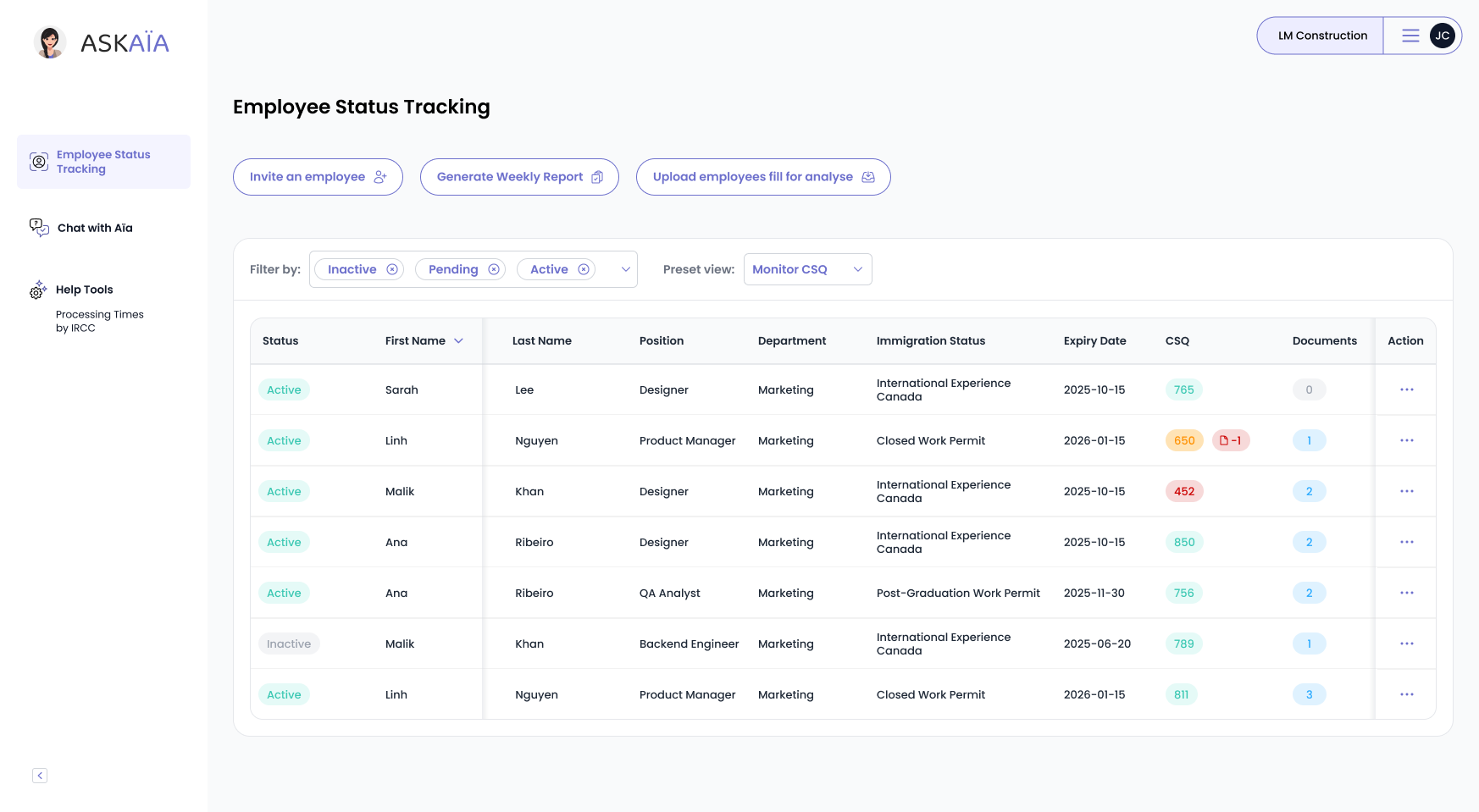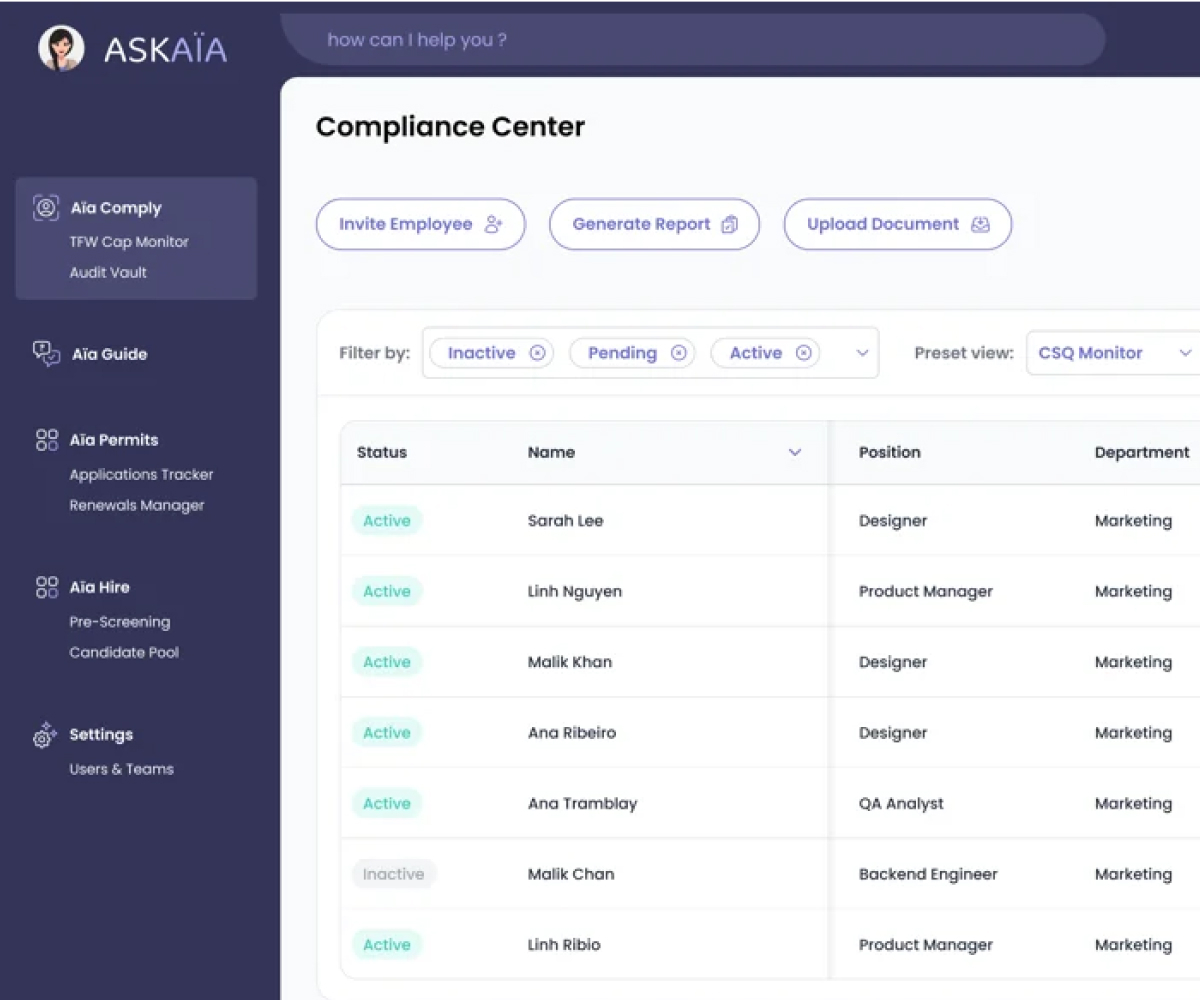AskAïa vs HRIS: Why HR Software Fails on Immigration in Canada

Everything is running smoothly in your HRIS: payroll is processed on time, schedules are clean, employee files are neatly organized. Then one morning, a forgotten detail blows up your management of foreign workers in Canada: a work permit that expired three weeks ago. The worker is still on the floor, and your entire production depends on them.
You then realize this isn’t a human error. It’s a system limitation. HRIS tools manage employees, not immigration rules or HR and immigration compliance in Canada. Dates, programs, legal obligations… none of that is really covered. That’s where AskAïa steps in and secures what your HRIS can’t handle.
Key takeaways
- An HRIS manages your employees, but not immigration.
- Permits, critical dates and proof of compliance often fall outside the system.
- AskAïa completes your HRIS with a specialized layer for foreign workers.
- The result: less risk, less stress, and a company ready for any inspection.
Why and when your HRIS is no longer enough for immigration
Managing a “regular” employee and managing a foreign worker are not the same reality.
For each foreign worker, you need to track:
- several key dates: work permit, LMIA validity, medical exam, passport expiry, end of contract, renewal deadlines;
- a specific program: Temporary Foreign Worker Program (TFWP), International Mobility Program (IMP), provincial nominee programs (PNPs), Express Entry, permanent residence, etc.;
- conditions that must be respected: job position, work location, hours, salary, benefits;
- supporting documents: work permit, LMIA decisions, IRCC or Service Canada letters, proof of wages, passport and previous status in Canada, offer letters and basic proof of residence.
On top of that, rules change regularly. Thresholds, timelines and programs are adjusted by the federal government and the provinces and territories. What was true last year may not be true this year.
A general HRIS is very good at managing employees. It is much weaker when it comes to:
- turning legal rules into business logic;
- triggering the right actions at the right time;
- guaranteeing solid proof of compliance in case of inspection.
Beyond a certain volume, this gap becomes a real breaking point.
Typical warning signs:
- you manage 10 or more foreign workers;
- you have more than one site or multiple shifts;
- you juggle several permit types (TFWP, IMP, students, spouses, etc.);
- you receive increasing individual questions about permanent residence, family, renewals;
- you rely on one person internally or externally to “know where each file stands”.
At that point:
- critical dates are no longer fully under control;
- documents are scattered across email, HRIS, shared drives, USB keys;
- the departure or absence of one key employee becomes a compliance risk.
Your HRIS is still doing its job… but it was simply never designed to absorb this level of complexity.
To go further: check out our comparison AskAïa vs Excel
How AskAïa completes your HRIS for immigration compliance
AskAïa doesn’t replace your HRIS. It completes it on a very specific dimension: managing foreign workers and immigration compliance in Canada.
Concretely, AskAïa adds:
- a complete immigration profile per worker, with statuses, programs, key dates, risks and next steps;
- automated alerts and site-based dashboards to track deadlines, permits and risks in real time;
- a worker-facing experience through Aïa, the assistant that answers foreign workers’ questions and guides them through their steps.
Your HRIS remains the backbone of your HR operations (payroll, scheduling, time off). AskAïa adds the missing layer: legal logic, risk management, permit tracking, and support for foreign workers.
To learn more, explore Aïa Comply, our module dedicated to immigration compliance. Together, they form a complete system: your HRIS manages the employee, and AskAïa manages the rules that allow you to keep them legally.
AskAïa vs HRIS: Who really does what?
An HRIS is excellent for organizing daily HR. AskAïa is excellent for managing immigration and compliance. Together, they make a complete system. Taken separately, there’s always a missing piece.
HRIS vs AskAïa comparison table
| Standard HRIS | Aïa Comply | |
|---|---|---|
| Employee file / HR data |
Yes: employee record, contact info, job, department | Yes, enriched with a complete immigration profile per worker |
|
Payroll, time, absences
|
Yes: payroll, schedules, time, time off | Relies on HRIS data |
|
HR processes (hiring, onboarding, reviews)
|
Yes: general HR workflows | No, focuses on steps linked to permits and status |
|
Immigration program logic
|
No | Yes: TFWP, IMP, PNPs, PR, Express Entry, possible transitions |
| Permit and key date tracking |
Partial: isolated date fields, manual reminders | Yes: structured dates, statuses, risks, next steps |
| Triggering actions at the right time |
No | Yes: 30/60/90-day alerts and tasks tied to deadlines |
| Compliance evidence (LMIA, wages, etc.) |
Not structured, scattered across documents | Yes: centralization and tracking of evidence for audits |
| IRCC / Service Canada / provincial audits |
No | Yes: dashboards and files ready for inspection |
| Risk tracking by site / permit type |
No
|
Yes: view by site, program, worker
|
| Foreign worker questions |
No
|
Yes: Aïa assistant for PR, family, timelines, obligations
|
| Immigration strategy per employee |
No
|
Yes: scenario and next recommended step by person
|
In plain terms: your HRIS manages your employees. Aïa Comply manages the rules that allow you to keep them legally.
Business case: Why extending your HRIS is more expensive than adding AskAïa
At some point, every Canadian employer relying on foreign workers faces the same dilemma:
“Can’t we just add one more custom field in the HRIS, or ask the vendor to adapt the system?”
Short answer: yes, but it won’t solve the real problem.
An HRIS is not designed to integrate immigration legal logic. Every customization becomes a fragile patchwork that depends on one person and is nearly impossible to audit properly.
HR time lost without AskAïa
- 20 to 40 minutes per foreign worker every week, just to check dates, documents and follow-ups;
- 5 to 10 hours per renewal gathering all evidence required by IRCC or Service Canada;
- several weeks of stress during an audit, because no file is ever truly complete.
Real cost of a mistake or missed deadline
- fines, reimbursements, and possible suspension of your ability to hire foreign workers;
- production interruptions if a permit expires.
A single incident often costs more than a full year of AskAïa.
What AskAïa changes, concretely
- critical dates no longer depend on someone’s personal calendar;
- compliance evidence is always audit-ready;
- renewals are anticipated and documented;
- overall risk goes down.
Your HRIS organizes. AskAïa secures.
Your HRIS structures HR operations. But when it comes to immigration, it leaves a blind spot. Dates, permits, evidence, risk, none of this is built into traditional HR systems.
AskAïa fills that gap with legal logic, alerts, audit-ready documentation, and support for foreign workers. The result: a complete HR system that reduces risk and gives you back control.
Want to understand your risks in under 5 minutes? Request a free mini-audit or book an Aïa Comply demo.

Let’s get your demo started
Book a demo
You May Also Like
These Related Stories

Aïa Comply - Canada's new HR compliance standard
Each compliance error is costly, with fines of up to $100,000 and thousands of lost HR hours. After analyzing over 5,000 real-life cases and 100 HR in …

How to Prepare for a TFW Program Inspection
Canadian employers face rising scrutiny under the Temporary Foreign Worker Program (TFWP). Since 2020, the number of inspections has increased by over …

AskAïa vs Spreadsheet: Stop HR Compliance Risks Before They Cost
Picture this: an HR coordinator juggling Excel trackers and long email threads. One permit renewal slips through — $13,000 in risk, production halted, …

